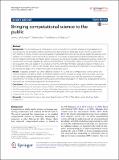Files in this item
Bringing computational science to the public
Item metadata
| dc.contributor.author | McDonagh, James | |
| dc.contributor.author | Barker, Daniel | |
| dc.contributor.author | Alderson, Rosanna Grace | |
| dc.date.accessioned | 2016-05-30T16:30:03Z | |
| dc.date.available | 2016-05-30T16:30:03Z | |
| dc.date.issued | 2016-03-02 | |
| dc.identifier | 215877438 | |
| dc.identifier | 62b8545e-c40a-47ba-9bca-c852ffbd53e8 | |
| dc.identifier | 84959515613 | |
| dc.identifier | 000373219300003 | |
| dc.identifier.citation | McDonagh , J , Barker , D & Alderson , R G 2016 , ' Bringing computational science to the public ' , SpringerPlus , vol. 5 , no. 259 . https://doi.org/10.1186/s40064-016-1856-7 | en |
| dc.identifier.issn | 2193-1801 | |
| dc.identifier.uri | https://hdl.handle.net/10023/8900 | |
| dc.description | The authors acknowledge the BBSRC Doctoral Training fund (ACH0- BDTG09) for funding this research. | en |
| dc.description.abstract | Background The increasing use of computers in science allows for the scientific analyses of large datasets at an increasing pace. We provided examples and interactive demonstrations at Dundee Science Centre as part of the 2015 Women in Science festival, to present aspects of computational science to the general public. We used low-cost Raspberry Pi computers to provide hands on experience in computer programming and demonstrated the application of computers to biology. Computer games were used as a means to introduce computers to younger visitors. The success of the event was evaluated by voluntary feedback forms completed by visitors, in conjunction with our own self-evaluation. This work builds on the original work of the 4273π bioinformatics education program of Barker et al. (2013, BMC Bioinform. 14:243). 4273π provides open source education materials in bioinformatics. This work looks at the potential to adapt similar materials for public engagement events. Results It appears, at least in our small sample of visitors (n = 13), that basic computational science can be conveyed to people of all ages by means of interactive demonstrations. Children as young as five were able to successfully edit simple computer programs with supervision. This was, in many cases, their first experience of computer programming. The feedback is predominantly positive, showing strong support for improving computational science education, but also included suggestions for improvement. Conclusions Our conclusions are necessarily preliminary. However, feedback forms suggest methods were generally well received among the participants; “Easy to follow. Clear explanation” and “Very easy. Demonstrators were very informative.” Our event, held at a local Science Centre in Dundee, demonstrates that computer games and programming activities suitable for young children can be performed alongside a more specialised and applied introduction to computational science for older visitors. | |
| dc.format.extent | 1256756 | |
| dc.language.iso | eng | |
| dc.relation.ispartof | SpringerPlus | en |
| dc.subject | Q Science (General) | en |
| dc.subject | DAS | en |
| dc.subject.lcc | Q1 | en |
| dc.title | Bringing computational science to the public | en |
| dc.type | Journal article | en |
| dc.contributor.institution | University of St Andrews. School of Chemistry | en |
| dc.identifier.doi | https://doi.org/10.1186/s40064-016-1856-7 | |
| dc.description.status | Peer reviewed | en |
This item appears in the following Collection(s)
Items in the St Andrews Research Repository are protected by copyright, with all rights reserved, unless otherwise indicated.

